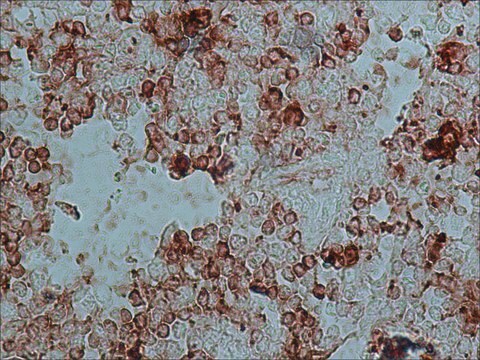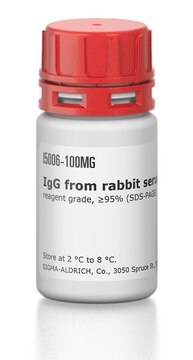R4880
Anti-Rabbit IgG (whole molecule) antibody produced in goat
affinity isolated antibody, lyophilized powder
Autenticatiper visualizzare i prezzi riservati alla tua organizzazione & contrattuali
About This Item
Clone:
polyclonal
application:
IEP
tecniche:
immunoelectrophoresis: suitable
citations:
16
Prodotti consigliati
Origine biologica
goat
Livello qualitativo
Coniugato
unconjugated
Forma dell’anticorpo
affinity isolated antibody
Tipo di anticorpo
secondary antibodies
Clone
polyclonal
Stato
lyophilized powder
tecniche
immunoelectrophoresis: suitable
Temperatura di conservazione
2-8°C
modifica post-traduzionali bersaglio
unmodified
Cerchi prodotti simili? Visita Guida al confronto tra prodotti
Descrizione generale
Binds all rabbit Igs.
Applicazioni
Anti-Rabbit IgG (whole molecule) antibody produced in goat is suitable as secondary antibody in immunoblotting.
Applications in which this antibody has been used successfully, and the associated peer-reviewed papers, are given below.
Western Blotting (1 paper)
Western Blotting (1 paper)
Azioni biochim/fisiol
IgG antibody subtype is the most abundant of serum immunoglobulins of the immune system. It is secreted by B cells and is found in blood and extracellular fluids and provides protection from infections caused by bacteria, fungi and viruses. Maternal IgG is transferred to fetus through the placenta that is vital for immune defense of the neonate against infections.
Altre note
Antibody adsorbed with human serum proteins.
Stato fisico
Lyophilized from 0.01 M sodium phosphate, 0.015 M sodium chloride, pH 7.2
Ricostituzione
Reconstitute with 0.135 M sodium chloride.
Esclusione di responsabilità
Unless otherwise stated in our catalog or other company documentation accompanying the product(s), our products are intended for research use only and are not to be used for any other purpose, which includes but is not limited to, unauthorized commercial uses, in vitro diagnostic uses, ex vivo or in vivo therapeutic uses or any type of consumption or application to humans or animals.
Non trovi il prodotto giusto?
Prova il nostro Motore di ricerca dei prodotti.
Codice della classe di stoccaggio
11 - Combustible Solids
Classe di pericolosità dell'acqua (WGK)
WGK 3
Punto d’infiammabilità (°F)
Not applicable
Punto d’infiammabilità (°C)
Not applicable
Dispositivi di protezione individuale
Eyeshields, Gloves, type N95 (US)
Scegli una delle versioni più recenti:
Possiedi già questo prodotto?
I documenti relativi ai prodotti acquistati recentemente sono disponibili nell’Archivio dei documenti.
I clienti hanno visto anche
On-site quantification of human urinary albumin by a fluorescence immunoassay.
Sunga Choi et al.
Clinical chemistry, 50(6), 1052-1055 (2004-05-27)
M Rudling et al.
The American journal of pathology, 153(6), 1923-1935 (1998-12-10)
The high-affinity degradation of low-density lipoprotein (LDL) is enhanced 3- to 100-fold in leukemic blood cells from patients with acute myelogenous leukemia (AML), suggesting an increased cellular LDL receptor expression. There are, however, inconsistencies regarding the published properties of LDL
Jinsu Kim et al.
ACS applied materials & interfaces, 7(4), 2891-2898 (2015-01-13)
We demonstrated a lateral flow immunoassay (LFA) for detection of viruses using fluorescently labeled M13 bacteriophage as reporters and single-reporter counting as the readout. AviTag-biotinylated M13 phage were functionalized with antibodies using avidin-biotin conjugation and fluorescently labeled with AlexaFluor 555.
Shanshan Huang et al.
Pathology, research and practice, 215(4), 794-800 (2019-01-27)
Numbers of studies have indicated that miRNA-708 plays an important role in many types of cancer. However, the role of miRNA-708 in pancreatic ductal adenocarcinoma (PDAC) has yet to be fully elucidated. The present study aimed to investigate the role
Peter Engelhardt et al.
Methods in molecular biology (Clifton, N.J.), 369, 387-405 (2007-07-28)
Standard immunogold-labeling methods in transmission electron microscopy (TEM) are unable to locate immunogold particles in the depth direction. This inability does not only concern bulky whole mounts, but also sections. A partial solution to the problem is stereo inspection. However
Il team dei nostri ricercatori vanta grande esperienza in tutte le aree della ricerca quali Life Science, scienza dei materiali, sintesi chimica, cromatografia, discipline analitiche, ecc..
Contatta l'Assistenza Tecnica.










